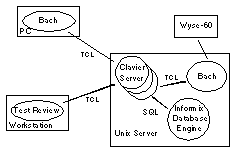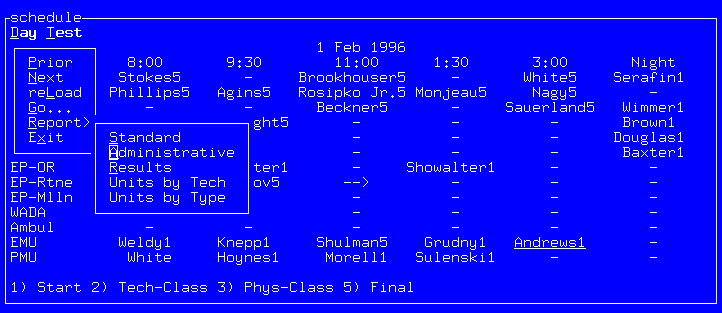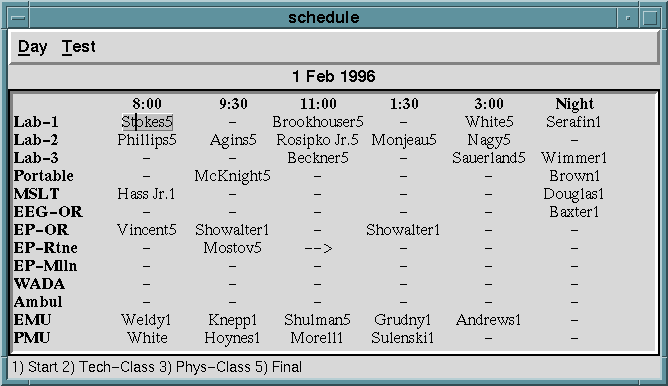

The following paper was originally published in the
Proceedings of the
USENIX
Fourth Annual
Tcl/Tk Workshop
Monterey, California, July 1996.
For more information about
USENIX Association
contact:
A Clinical Neurophysiology Information System based on Tcl/Tk
Martin B. Andrews and Richard C. Burgess
Section of Neurological Computing
Department of Neurology
The Cleveland Clinic Foundation
9500 Euclid Ave
Cleveland, OH 44195
andrewm@ccfadm.eeg.ccf.org
Abstract
The Department of Neurology at the Cleveland Clinic
has replaced a restricted patient information system
with a new one based on Tcl/Tk. Tcl/Tk along with
several novel extensions provides the base for creating
portable client-server database applications. These
extensions and some of the clinical applications are
presented.
1. Introduction
The Cleveland Clinic is a large multi-specialty medical
center with a high volume of both inpatient and
outpatient evaluations. One of the largest departments,
Neurology, is a leader in the care of patients with
epilepsy and other neurological disorders. Along with
physical examinations, imaging studies and laboratory
tests patients are evaluated with neurophysiological
tests like EEG (brain wave tests) and PSG (sleep tests).
Tests are performed using computer-based acquistion
and review systems developed by the Section of
Neurological Computing. This section is reponsible for
the information needs of the department, and provides
networked databases to physicians, nurses,
technologists and secretaries. These systems and
software products have also been made available for
use at other institutions through the Vangard
subsidiary.
The Neurology department's patient information
system, EBase, was integral to daily operations and
research studies. It was also unreliable, difficult to use
and even more difficult to program. A major overhaul
of the code was enacted to remove bugs and hardware
dependencies. The resulting system, EBase2, was more
reliable but development was still painfully slow.
Particularly hard to develop were the highly
customized user interactions demanded by our users.
To overcome this problem a radical redesign of EBase
was initiated. Informix-4GL, the proprietary
programming language used in earlier revisions, was
dumped. The requirements for the new EBase3 were
as follows:
- Rapid Development
- The burgeoning
development of new clinical tests, a desire for
faster reporting of test results and a need to
reduce costs drive an ever growing demand
for information to be maintained by EBase.
In addition, vague user requirements
necessitate quick prototyping. Programmers
must be able to quickly extend EBase.
- Ease of Use
- Our users demand an intuitive
and stream-lined user interface. These
somewhat contradictory needs can be met
with flexible user interface components that
are customized for particular groups of users.
Even further flexibility is required if other
institutions are to use EBase.
- Portability
- Departmental users access EBase
from Unix workstations, PCs running
Microsoft Windows, and Wyse 60 terminals
attached to a Unix server. All of these devices
must be supported. For EBase to be used at
other institutions it must be portable to even
more client devices, and even a variety of
server platforms.
- Simple API
- The section of neurocomputing
also develops software to acquire and review
neurology test data. A simple API for
accessing the EBase database is desired for
use in these systems.
- Inexpensive Licensing
- The cost of
development tools was an important issue
because of our own budget limitations and,
more importantly, the need to provide a
competitively priced package to other
institutions. Even tools without run-time fees
generally charge per target platform - a
problem considering the number of targets to
be supported.
The resulting design for EBase3 uses Tcl to help meet
these goals. The core of EBase3 is an extended Tcl
interpreter called Clavier. Clavier controls all access to
the patient database. It enforces data integrity rules and
hides implementation details of the database schema.
Only Clavier sends SQL commands to the database
engine. Clients send requests to Clavier via TCP/IP in
the form of Tcl commands. The client itself does not
require a Tcl interpreter, but the most common client is
an extended Tcl interpreter called Bach. Bach is a
generic tool for building GUI database applications.
Applications for Bach are Tcl scripts. A version of
Bach exists for X based workstations, and character
terminals connected to a Unix server. A version for
Windows based PCs is being developed. Clients that
do not include a Tcl Interpreter use a small C library to
send Tcl requests to Clavier. The components of
EBase3 are depicted in figure 1. The design uses the
three-tiered architecture being embraced by packages
like PowerBuilder[1].

Figure 1. EBase3 Components.
An elegant feature of the EBase3 design is that the
Bach client can load all the Tcl code from Clavier.
This feature simplifies maintenance by providing a
single point of installation, and allows easy operation
over a wide area network.
The remainder of this paper consists of three major
sections. Section 2 describes the Tcl extension
packages used in the Bach server and client. Section 3
presents some applications implemented using the Bach
client. Section 4 concludes with observations from the
EBase3 project.
2. Tcl Extensions
Clavier and the Bach client include many Tcl
extensions to simplify the creation of an information
system. Both Clavier and Bach include the
object-oriented programming extension OTcl [2]. The
PC and workstation versions of Bach include Tk as the
basis for their user interface. The character terminal
version of Bach includes CTk, a curses based
replacement for Tk that is discussed in the next section.
All Bach versions include the table geometry manager
from BLT that simplifies the layout of forms, and
Stephen Uhler's HTML library for rendering formatted
text. In addition to these outside-developed extensions,
several new extensions have been developed at the
Cleveland Clinic. These in-house extensions are
presented in the following subsections.
2.1 CTk
Curses Tk, or CTk, is a replacement for Tk that
displays to character terminals. The user interface is
navigated using keyboard bindings mostly compatible
with Tk (some differences occur because most
terminals do not support the range of modifier keys
used in Tk). While not as pleasant to use as Tk, CTk
provides an important fall back when Tk cannot be
used. Besides the obvious case when only a character
terminal is available, CTk has also proven useful for
remote access. A screen snapshot of the EBase3
schedule application running under CTk is shown in
figure 2. Like Tk, CTk is written in C except for event
bindings, which are defined in Tcl.

Figure 2. EBase3 Schedule application using CTk.
CTk supports the majority of Tk commands, but the
differences require existing Tk applications to be
modified to run under CTk. It easy to write
applications that will work with both Tk and CTk if this
goal is considered from the outset. For an application
to be portable to Tk and CTk, the most important
requirements are resolution independence and support
for small screens. These attributes are useful even for
applications solely intended for Tk.
2.2 Rdb
Rdb provides a Tcl interface to relational databases.
Currently, Rdb only provides an interface to Informix.
Rdb is loosely based on DBI [3], the universal database
interface being developed for perl, so it is intended to
interface with a variety of database engines. An
example Tcl script using Rdb is shown in figure 3. Rdb
includes the flexible error handling scheme from DBI
that supports recovery from failed database commands.
It also supports access to BLOBs. Rdb is implemented
entirely in C.
informix connect myConn "mydatabase"
myConn prepare mySelect {
select id, first_name, last_name from employees
where last_name matches ?
order by last_name, first_name
}
mySelect execute A*
while {[mySelect into vals]} {
puts "$vals(id) - $vals(last_name), $vals(first_name)"
}
Figure 3. Tcl script using the Rdb command "informix". It prints all
employees whose last name begins with "A".
2.3 Bach
The Bach extension is a library of database utilities us
ed in both Clavier and the Bach client. It defines
network commands and OTcl classes for domains,
fields, forms and reports. Bach is implemented in a
mixture of C and Tcl.
The Bach network commands provide a simple method
for sending Tcl commands via TCP/IP. In addition, the
Bach library includes a short wrapper for the Tcl source
command that allows the Bach client to auto-load Tcl
files from Clavier.
Domains are OTcl objects that provide easy access to
a database. A domain represents a set of member
values, and defines a list of attributes for its members.
Each attributes itself has an associated domain. For
example, date is a domain and one of its attributes is
year. The domain of the year attribute is integer. In
addition to algorithmic domains like date and integer,
Bach includes the SqlTable class for domains
representing the rows of a relational database table.
Bach automatically defines parameterized types like
character(20), the set of all character strings with length
20 or less, by patching the unknown Tcl command.
Domains also specify default fields, forms, and reports
for depicting members of the domain.
Fields are widget classes that can take on any value
from their assigned domain. All fields provide
methods for storing, retrieving, and validating their
value. Forms are mega-widget classes containing one
or more fields. A simple form layout can be generated
automatically, or an intricate layout can be specified
explicitly.
The Report class provides the basis for generating
HTML formatted reports. Using HTML provides a
natural method for browsing records in the database.
HTML is used for all formatted text in EBase3,
removing the need for separate code for printing or
viewing a record. To facilitate printed reports,
non-standard mark-up tags and attributes are used to
control features like page breaks and page orientation.
A custom HTML formatter interprets these
non-standard notations and outputs the report in
PostScript, HP-PCL, or ASCII format. The HTML
report formatter is an independent program
implemented in C.
3. Applications
EBase applications are Tcl scripts executed by the Bach
client. These applications share a common library of
Tcl code that defines domains specific to EBase, and
their associated user interface components. The EBase
library currently consists of 8000 lines of Tcl code,
over half of which is for the complex domain
representing neurology tests. Neurology tests have
thirty attributes including complex items like findings
and classification that contain many attributes
themselves. The actual format of these complex
attributes is determined by the study type of the test.
The neurology test form is depicted in Figure 4.

Figure 4. Form for editing Neurology Tests.

Figure 5. EBase3 patient application.
The Patient application, shown in Figure 5, provides
easy access to all EBase records associated with a
single patient. Users are presented with the patient
demographics and a concise medical history. Selecting
a history entry opens a hypertext browser. At any
point, a form can be opened to update or add new
patient records. The schedule application, shown in
Figure 6, presents neurology tests by the date they were
performed. In addition to scheduling or rescheduling
tests, the user can enter the hypertext browser by
selecting one of the entries. In addition, the schedule
application provides a collection of administrative
reports. Both of these applications are short Tcl scripts:
the patient script contains 221 lines, the schedule script
376 lines.

Figure 6. EBase3 schedule application using Tk.
4. Conclusion
EBase3 has succeeded in creating a portable
information system that is easy to use and extend. It is
in production use in an environment that schedules 800
tests per month and averages a dozen active users. The
new system has been greeted enthusiastically by a wide
range of users including secretaries, technologists,
physicians, and staff in training.
The tools created for EBase3 have also shown promise
for use in other information systems. Clavier and the
Bach client were used to create a modest application to
generate project status reports. This application
manages six database tables, and includes five forms
and one report. It required only 550 lines of Tcl code.
I initially considered Tcl for use in EBase3 not because
of any attribute of Tcl itself, but because of the Tk
Toolkit. While the Tk toolkit has succeeded in
providing a rich user interface for EBase3, Tcl itself
has proven well suited to departmental information
systems, where rapid development is usually more
important than blazing performance and most of the
work consists of string manipulation and interacting
with the user. The main problems discovered with Tcl
are listed below.
- Performance
- While performance was not the
main concern in EBase3, there were times
where Tcl was too slow even for high level
functions. Performance problems have been
overcome by recoding commands in C, but
this is not an ideal solution. In addition to the
greater development effort required by C, C
code must be built and installed on all of the
client platforms. Tcl code only needs to be
installed on the Clavier server. The eagerly
awaited on-the-fly Tcl compiler will hopefully
solve this problem. Tight integration with
Java is another possible solution.
- Development Tools
- GUI development tools
for Tcl would further the goal of rapid
application development, and greatly assist in
bringing new programmers up to speed. The
SpecTcl project [4] at Sun Labs addresses the
need for a GUI builder. A source browser
(supporting object-oriented programming)
and a debugger are also needed. Production
grade tools are a must.
References
- Powersoft, Building Distributed PowerBuilder
Applications, Powersoft, Concord, MA, 1995.
- David Wetherall and Christopher J. Lindblad,
Extending Tcl for Dynamic Object-Oriented
Programming, 1995 Tcl/Tk Conference Proceedings.
- Tim Bunce, Perl 5 Database Interface (DBI) API
Specification, Draft Version 0.6, 1994.
- Stephen Uhler, A Graphical User Interface Builder
for Tk, 1995 Tcl/Tk Conference Proceedings.






